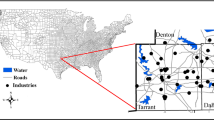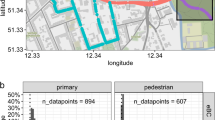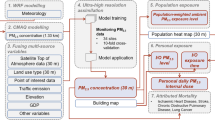Abstract
We developed an exposure estimation model for an epidemiological study on the effect of traffic-related air pollutants on respiratory diseases. The model estimates annual average outdoor concentration of nitrogen oxides (NOx) and elemental carbon (EC). The model is composed of three nested plume dispersion type submodels treating different spatial scales from a few meters to tens of kilometers. The emissions from road traffic was estimated at high spatial resolution along the paths of roads taking into account the effects of individual building shape and traffic signals to secure accuracy near trunk roads where most of the subjects of the epidemiological study resided. Model performance was confirmed by field measurements at permanent local government stations and purpose-built temporary stations; the latter supplemented roadside monitoring points and provided EC concentrations, which are not measured routinely. We infer that EC emissions were underestimated by using the available database because there were significant contributions to EC concentrations from sources that did not emit much NOx. An adjustment concentration yielded good agreement between model estimates and field measurements.
This is a preview of subscription content, access via your institution
Access options
Subscribe to this journal
Receive 6 print issues and online access
$259.00 per year
only $43.17 per issue
Buy this article
- Purchase on Springer Link
- Instant access to full article PDF
Prices may be subject to local taxes which are calculated during checkout










Similar content being viewed by others
References
Health Effects Institute. Traffic-related air pollution: a critical review of the literature on emissions, exposure, and health effects. Special Report 17 2010.
Braback L, Forsberg B . Does traffic exhaust contribute to the development of asthma and allergic sensitization in children: findings from recent cohort studies. Environ Health 2009; 8: 17–27.
Brunkreef B, J Sunyer . Asthma, rhinitis and air pollution: is traffic to blame? Eur Respir J 2003; 21: 913–915.
Trasande L, Thurston GD . The role of air pollution in asthma and other pediatric morbidities. J Allergy Clin Immunol 2005; 115: 689–699.
Heinrich J, Wichmann H-E . Traffic related pollutants in Europe and their effect on allergic disease. Curr Opin Allergy Clin Immunol 2004; 4: 341–348.
Briggs DJ, de Hoogh G, Gulliver J, Willis J, Elliott P, Kingham S et al. A regression-based method for mapping traffic-related air pollution: application and testing in four contrasting urban environments. Sci Total Environ 2000; 253: 151–196.
Hoek G, Beelen R, de Hoogh G, Vienneau D, Gulliver J, Fischer P et al. A review of land-use regression models to assess spatial variation of outdoor air pollution. Atmos Environ 2008; 42: 7561–7578.
US-EPA, User’s guide for the Industrial Source Complex (ISC) dispersion models (revised) Volume 1,2, and 3. EPA-454/B-95-003a-c 1987.
US-EPA, User’s guide for the AMS/EPA regulatory model - AERMOD. EPA-454/B-03-001 2004.
Benson PE . A review of the development and application of the CALINE3 and 4 models. Atmos Environ 1992; 26B: 379–390.
Eichhorn J . Validation of a microscale pollution dispersal model. In: Gryning S-E, Schiermeier FA (eds). Air Pollution Modeling and Its Application XI. Plenum Pub: London. 1996 pp 539–548.
Yoshikawa Y, Kunimi H . Numerical simulation model for predicting air quality along urban main roads: first report, development of atmospheric diffusion model. Heat Transf Jpn Res 1998; 27: 483–496.
Pénard-Morand C, Schillinger C, Armengaud A, Debotte G, Chrétien E, Pellier S et al. Assessment of schoolchildren’s exposure to traffic-related air pollution in the French Six Cities Study using a dispersion model. Atmos Environ 2006; 40: 2274–2287.
Wu J, Houston D, Lurmann F, Ong P, Winer A . Exposure of PM2.5 and EC from diesel and gasoline vehicles in communities near the Ports of Los Angeles and Long Beach, California. Atmos Environ 2009; 43: 1962–1971.
Japan Environmental Agency. Manual for Regulation of Total Emission of Nitrogen Oxides (in Japanese). Environmental Research and Control Center: Japan. 2000.
Highway Environment Research Institute. Environmental Impact Assessment Technique for Road Project 2000; Vol. 2.
Kanda I, Yamao Y, Ohara T, Uehara K . An urban atmospheric diffusion model for traffic-related emission based on mass-conservation and advection-diffusion equations. Environ Model Assess 2013; 18: 221–248.
Kanda I, Yamao Y, Uehara K, Ohara T . Development of a roadside atmospheric diffusion model MCAD. Research Report. National Institute for Environmental Studies: Japan, No. 207 http://www.nies.go.jp/kanko/kenkyu/index-e.html2012.
Kannari A, Tonooka Y, Baba T, Murano K . Development of multiple-species 1km x 1km resolution hourly basis emissions inventory for Japan. Atmos Environ 2007; 41: 3428–3439.
Agency for Natural Resources and Environment, Sogo Enerugi Tokei (Comprehensive Energy Statistics) FY2007 (in Japanese) 2009.
Ministry of Land, Infrastructure, Transport and Tourism, FY1999 Road Traffic Census (in Japanese) 2000.
Ministry of Land, Infrastructure, Transport and Tourism, FY2005 Road Traffic Census (in Japanese) 2006.
Ministry of Land, Infrastructure, Transport and Tourism, Survey on Motor Vehicle Transport (in Japanese), 2004, 2005, 2006, 2007, 2008.
Ministry of Environment, Study report on the Environmental Effects of automobile traffic (in Japanese) 2005.
Automobile Inspection and Registration Information Association, National Database on Vehicle Registration (in Japanese), 2006, 2007.
Naser TM, Kanda I, Ohara T, Sakamoto S, Kobayashi S, Nitta H et al. Analysis of traffic-related NOx and EC concentrations at various distances from major roads in Japan. Atmos Environ 2009; 43: 2379–2390.
Kondo H, Tomizuka T . A numerical experiment of roadside diffusion under traffic-produced flow and turbulence. Atmos Environ 2009; 43: 4137–4147.
Chang JC, Hanna SR . Air quality model performance evaluation. Meteorol Atmos Phys 2004; 87: 167–196.
Kanda I, Yamao Y, Uehara K, Ohara. T . A wind-tunnel study on diffusion from urban major roads. J Wind Eng Ind Aerodyn 2006; 94: 659–673.
Cyrys J, Heinrich J, Hoek G, Meliefste K, Lewne M, Gehring U et al. Comparison between traffic-related particle indicators: Elemental carbon (EC), PM2.5 mass, and absorbance. J Expo Anal Environ Epidemiol 2003; 13: 134–143.
Acknowledgements
The work was conducted as a part of the SORA project administered by the Japanese Ministry of Environment.
Author information
Authors and Affiliations
Corresponding author
Ethics declarations
Competing interests
The authors declare no conflict of interest.
Additional information
Supplementary Information accompanies the paper on the Journal of Exposure Science and Environmental Epidemiology website
Supplementary information
Rights and permissions
About this article
Cite this article
Kanda, I., Ohara, T., Nataami, T. et al. Development of outdoor exposure model of traffic-related air pollution for epidemiologic research in Japan. J Expo Sci Environ Epidemiol 23, 487–497 (2013). https://doi.org/10.1038/jes.2013.29
Received:
Revised:
Accepted:
Published:
Issue Date:
DOI: https://doi.org/10.1038/jes.2013.29
Keywords
This article is cited by
-
Association between traffic-related air pollution and development of asthma in school children: Cohort study in Japan
Journal of Exposure Science & Environmental Epidemiology (2014)



